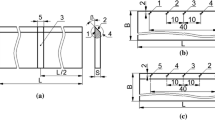Abstract
Dulling of high-speed steel (HSS) cutting tools after milling five wood species has been analyzed. The wood investigated varied in mineral contamination, high-temperature corrosivity (HTC) and density (D). Experiments performed proved that up to date methods for evaluation of mineral contamination in wood should be improved. A new pipe-like form of mineral contamination particles was evidenced. The correlation between the presence of 3D aggregates of silica in wood and high content of K and Ca in the ash was established. Employing multivariable theoretical simulation method, the combined effect of mineral contamination, HTC and wood density on the tool dullness appeared to be a reasonable explanation of the results obtained.






Similar content being viewed by others
References
Amos GL (1952) Silica in timbers, no. 267. CSIRO, Australia, p 61
Bermudez J, Ohtani T, Tanaka C (2005) The machinability of nogal (Cordia alliodora) grown in Colombia. J For Biomass Use Soc:7 (in press)
Darmawan W, Tanaka C, Svoradova M, Marchal R (2003) Chemical and mechanical wearing of high speed steel and tungsten carbide by some Indonesian woods. In: Proceedings of the 16th international wood machining seminar (IWMS), Shimane University, Matsue, Japan, pp 487–493
Porankiewicz B (1993) Catastrophic wear mechanism when milling particle board. In: Proceedings of the 11th IWMS, Oslo, Norway, pp 509–514
Porankiewicz B (2003) A method to evaluate the chemical properties of particle board to anticipate & minimize cutting tool wear. Wood Sci Technol 37(1):47–58
Porankiewicz B (2004) Theoretical simulation of cutting edge wearing when wood and secondary wood products cutting. Wood Sci Technol:11 (in press)
Porankiewicz B, Sandak J, Tanaka C (2003) The HSS tool wear when milling wood. In: 16th IWMS, Matsue, Japan, vol 2, pp 494–502
Porankiewicz B, Sandak J, Tanaka C (2005) Factors influencing steel tool wear when milling wood. Wood Sci Technol 39(3):225–234
Acknowledgments
Theoretical simulation calculations were performed at Poznań Supercomputing–Net Center PCSS. Some part of this research has been performed during post doc financed by Provincia Autonoma di Trento, Italy.
Author information
Authors and Affiliations
Corresponding author
Rights and permissions
About this article
Cite this article
Porankiewicz, B., Iskra, P., Sandak, J. et al. High-speed steel tool wear during wood cutting in the presence of high-temperature corrosion and mineral contamination. Wood Sci Technol 40, 673–682 (2006). https://doi.org/10.1007/s00226-006-0084-7
Received:
Published:
Issue Date:
DOI: https://doi.org/10.1007/s00226-006-0084-7




